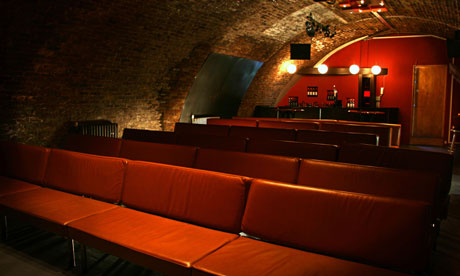
A rainy Monday in March in Loughborough Junction has, at first glance, nothing to do with the hot and bustling streets of Calcutta. Yet this particular evening had everything to do with it, because Street Food Kolkata Experience was in residency at the Whirled Cinema. Street Food Kolkata is the brainchild of Angus Duncan, chef turned filmmaker. The Experience brings together his love of the Bengali street food (chaat, which means ‘to lick’) and his film that documents his continual fascination with the street traders: you can taste, hear and see the vibrancy of the city for yourself. Four little food carts were set up around the cinema which was, for the evening, decorated to echo a colourful Calcuttan street corner. The room was scented with spice and incense. Bengali music serenaded guests, with street noises acting as segue between tracks – bike bells, shouts, horns – all of which created an atmosphere that was warm and electric.
Streatham-based Angus visited Calcutta for the first time nine years ago, and his love affair with the city was born. He became fascinated with the Bengalis and their passion for the sensual pleasures of living: literature, theatre and of course, food. Their culture of eating is different from ours in that everyone, from all socioeconomic levels, is interested in food. From both a pleasure and a nutritional perspective, the Bengalis understand how to get the very best from the food available to them; there is little interest in eating anything that does not benefit them both in flavour and health. Comparing this mindset to our standard Western diet in which few think of the health benefits associated with what they eat, it is a simple yet revolutionary concept.
The film is beautiful. Capturing the city at its truest, the film spends a day with the traders, from their early morning rising, to setting up their stalls, the marketing, the techniques and the most important bit, the eating. The film makes fascinating viewing and is dotted throughout with interviews with traders, eaters, and local foodies, if such a word can even exist in a place where poverty is the norm. The Bengali diet bears some references from the city’s history as a main port city for hundreds of years. Flavours brought in from the Chinese, Nepalese, Dutch, Portuguese and Muslims have all had their influence and the Bengalis have adopted some, yet the outcomes are wholly their own. There is no running water and no gas, yet the traders are able to produce fresh food that is a mix of tastes and textures. Fresh herbs are on everything. Their offerings are filling, the flavours are interesting to the palate, satisfying and most importantly, healthy. Their hands are agile and quick. They cook over makeshift stoves of hot coal and use cooking techniques that are the pinnacle of efficiency. In our over-sanitised society, it was fascinating to see how much food can be produced on the side of the street, prepared in the simplest fashion, yet with optimum health benefits.
The chaats available on the night were a spectacular display of the flavours and textures illustrated in the film. Jhal muri was a crunchy, spicy, sweet and sour snack, thanks to fresh lime juice, cucumber, ginger, onions, tamarind sauce, hard chickpea noodles, puffed rice and fried lentils. It packed some serious heat but was utterly delicious. Ghungi, so simple its execution, was a revelation of taste. Served in a dried banana leaf bowl, chickpea noodles soaked up red lentil daal, which was then garnished with tomatoes, ginger, garam and chaat masalas (which contains black salt), coconut, coriander and topped with tamarind. Other goodies were puchkas
, small semolina and wheat flour puffs, stuffed with mashed potato and mustard oil, with a touch of mint water and tamarind and named for the sound they make when you crush them in your mouth. Dhoklas were a slice of savoury chickpea flour sponge topped with plain yoghurt, hari chutney (chilli, coriander, lime and ginger), date and raisin chutney, fresh coconut and a sprinkling of garam masala; an equally interesting dish to the ghungi
,but with even more texture. Sweets also made the cut: a delicious mango yoghurt lassi with coconut, a squeeze of lime juice, and little pieces of delicious Bengali doughnuts that soaked up a small amount of liquid but held their own and made a nice crunchy finish.
An education for both mouth and mind, the Experience is a unique and marvelous way to introduce Bengali street food and culture to South London. The Street Food Kolkata Experience was not the first and it definitely won’t be the last, but whilst you’re waiting for your next opportunity to see the film, track down Angus’ street food stall to try his wares.
Angus sells his chaats around Brixton and Central London. He is also available for private parties and events. His websites and Twitter are the best way to find out more.
Lindsay blogs at www.blondvsbland.com
http://mongodenoon.wordpress.com/
http://www.streetfoodkolkata.com/thefilm.html#film
https://twitter.com/jhalmuriexpress













